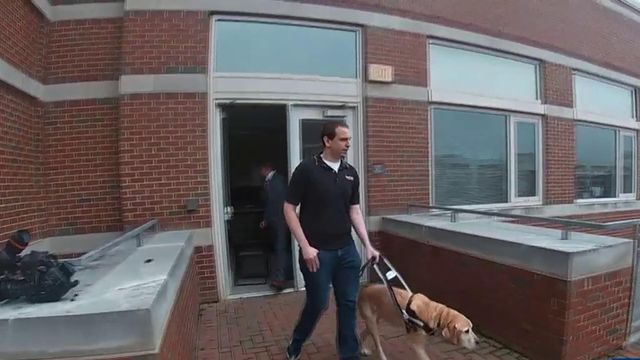NC State research helps puppies to become guide dogs
According to the World Health Organization, an estimated 2.2 billion people are visually impaired or blind, and not every person is guaranteed to get a guide dog to assist them. One Ph.D. student’s research at North Carolina State University is helping pick which puppies will successfully become a service dog.
Sean Mealin, who is legally blind, has gained a sense of freedom, mobility and more with his seeing-eye dog, Simba.
“I’d say he’s my best friend, and he’s also a way I gained independence” Mealin said.
Mealin has worked the computer science department at NC State for almost five years to gather data from smart dog collars, a collaboration project with university, IBM and Guiding Eyes for the Blind. The collars are worn by puppies training to become guide dogs. Mealin helps design data collection systems that are used when the puppies are 7 weeks old.
Before Mealin can collect data, the puppies start off by working with volunteers. Lorraine Trapani is a volunteer puppy-raiser with Guiding Eyes for the Blind. She became a volunteer in honor of her husband, who lost his vision after being diagnosed with cancer.
“I got a special appreciation for the challenges even a partial loss of vision can bring to everyday life,” Trapani said. She has volunteered as a puppy-raiser for almost 9 years.
Guiding Eyes for the Blind provide the puppies to the volunteers. Ninety percent of the puppies are Labradors, both yellow and black, and the other 10 percent include German shepherds.
From 8 weeks old to about 15 or 16 weeks old, the puppies work with the puppy-raisers. During that period, the puppies wear the smart dog collars that monitor their emotional responses to real-life situations they’re likely to face as guide dogs.
Long-term training for guide dogs runs upwards of $50,000 per dog, but with the smart dog collars, program costs can be reduced. The collars can also increase the availability of qualified guide dogs.
Through the smart dog collar program, IBM technology helps researchers like Mealin at NC State help Guiding Eyes for the Blind predict which puppies are best fitted to work as successful guide dogs.
Mealin said his Ph.D. research has real-world consequences.
As someone who has benefited from a canine friend, Mealin is eager to see his research go beyond NC State and help others obtain a service dog.













